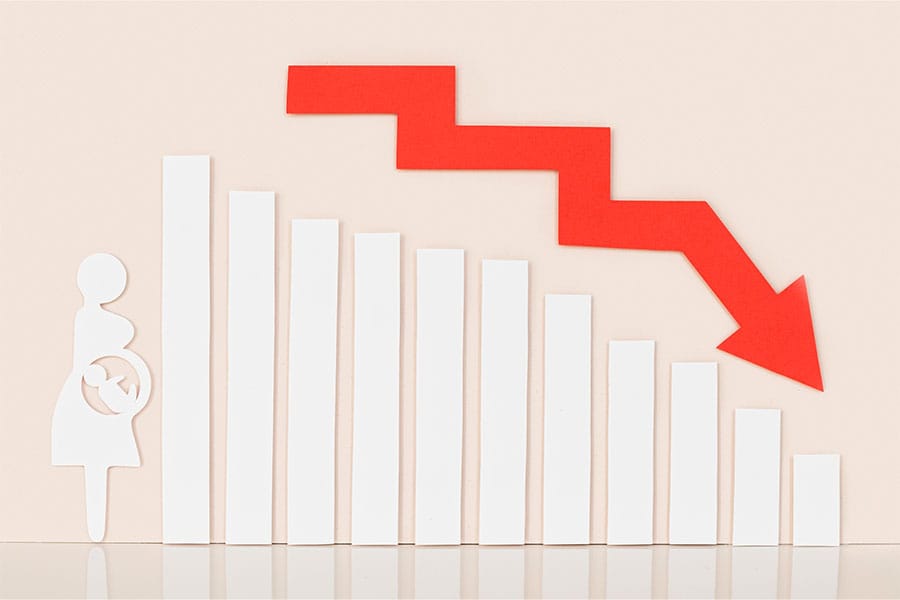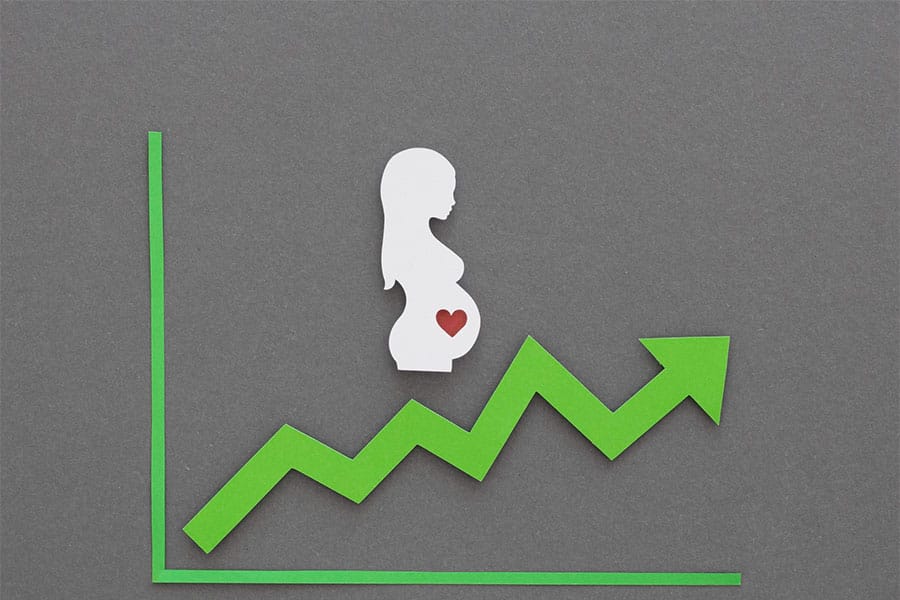Understanding the Decline in Fertility Rate in India and Its Significance
Introduction:
Fertility rates have always been a critical factor in shaping a nation’s demographics, socioeconomic landscape, and future. India, a country known for its cultural diversity and vast population, is currently grappling with a significant decline in its fertility rate. This article delves deep into the multifaceted reasons behind this decline, highlights its implications, and sheds light on the pivotal role that fertility rates play in the development of a nation. As we navigate through this complex topic, we’ll also explore how Womb IVF and Fertility Center offers hope and solutions to those seeking to overcome fertility challenges.
Understanding the Decline in Fertility Rate in India:
The gradual decline in fertility rates across India has garnered significant attention in recent years, prompting researchers, policymakers, and healthcare professionals to delve into the multifaceted factors contributing to this trend. While the causes of this decline are intricate and interwoven, several key factors stand out as primary contributors:
- The shift in Societal Norms and Values: The transition from traditional to more modern societal norms has brought about significant changes in family planning and reproductive choices. The once-prevailing preference for larger families has shifted as couples now opt for smaller families to align with their changing lifestyles, career aspirations, and educational pursuits.
- Educational Pursuits and Career Choices: Education has emerged as a powerful driving force behind the declining fertility rate. With more women pursuing higher education and establishing careers, family planning decisions are increasingly influenced by the desire to achieve personal and professional goals before starting a family. The postponement of marriage and pregnancy has become a common trend among educated women.
- Women’s Empowerment and Autonomy: The empowerment of women through increased access to education, awareness, and employment opportunities has empowered them to assert control over their reproductive choices. Women are more informed about family planning methods and are actively seeking means to space or limit pregnancies according to their preferences.
- Urbanization and Economic Factors: The process of urbanization has brought about significant changes in lifestyle and family dynamics. Rapid urbanization has led to smaller living spaces, increased costs of living, and a shift towards nuclear families. Economic considerations play a pivotal role in family planning decisions, as couples weigh the financial implications of raising children.
- Access to Contraceptives and Family Planning: Government initiatives and healthcare programs have led to improved access to family planning resources, including contraceptives and reproductive healthcare services. Increased awareness about family planning methods has provided individuals and couples with greater control over their reproductive health.
- Cultural Transition: As society evolves, cultural norms related to family size are also changing. The idea of a smaller family is gaining acceptance, especially among the younger generation who view it as a means to provide better opportunities and quality of life for their children.
- Delayed Marriages: With the emphasis on education and career development, the age at which people are getting married has increased. Delayed marriages naturally translate into delayed parenthood, contributing to the overall decline in fertility rates.
- Healthcare Advances: Improved healthcare services, especially maternal and child health, have led to better survival rates for infants and children. As child mortality rates decrease, the incentive to have larger families for fear of child loss diminishes.
The significance of understanding the decline in fertility rates lies in its far-reaching implications for various aspects of society and the nation’s future. This decline has the potential to reshape family structures, impact workforce dynamics, and influence healthcare and social welfare policies. By acknowledging the multifaceted nature of this phenomenon, policymakers and healthcare providers can develop targeted interventions to address the challenges posed by a declining fertility rate. In the face of these challenges, Womb IVF and Fertility Center stand as steadfast allies, offering expert guidance and innovative solutions to those seeking to overcome fertility hurdles and embrace the journey of parenthood.
The Significance of Fertility Rate and its Implications:
The fertility rate of a nation serves as a crucial barometer that reflects not only the reproductive choices of individuals and couples but also has far-reaching implications that reverberate across multiple sectors of society. Understanding the significance of fertility rates goes beyond mere statistical data; it offers insights into the social, economic, and demographic fabric of a country.
- Demographic Transition and Population Aging: A declining fertility rate contributes to what is commonly referred to as demographic transition. This transition involves a shift from high birth and death rates to lower ones, which in turn leads to changes in the age distribution of a population. With fewer births, the population pyramid narrows at its base, resulting in an aging population. While an aging population can be attributed to improved healthcare and longer life expectancies, it also poses unique challenges.
- Economic Dynamics and Workforce Sustainability: The fertility rate plays a pivotal role in shaping a country’s economic landscape. A balanced fertility rate ensures a sustainable and dynamic workforce, vital for economic growth and development. When fertility rates decline significantly, there is a potential mismatch between the working-age population and dependents, including the elderly and children. This can impact labor availability, productivity, and the ability to sustain social welfare programs.
- Healthcare and Elderly Care: A lower fertility rate leads to an aging population, which, in turn, exerts pressure on healthcare systems and resources. The elderly often require specialized medical care and support, including treatments for age-related conditions. Healthcare infrastructure and policies need to adapt to accommodate the changing healthcare needs of an aging population, ranging from chronic diseases to geriatric care facilities.
- Social Welfare and Pension Systems: Fertility rates are intrinsically tied to the functionality of social welfare and pension systems. As the elderly population increases, there is a higher demand for pension benefits and elderly care services. A decline in the number of younger individuals contributing to pension systems can strain government budgets and necessitate the restructuring of pension schemes.
- Gender Dynamics and Empowerment: The fertility rate can also offer insights into gender dynamics within a society. As fertility rates decline, women often gain more opportunities for education, career advancement, and personal growth. This empowerment contributes to narrowing gender gaps and fostering more equitable societies.
- Policy Planning and Resource Allocation: Fertility rates serve as critical data points for policymakers and government officials. Accurate fertility rate data helps in planning and allocating resources for healthcare, education, family support, and social welfare programs. Inaccurate or outdated fertility rate information can lead to misinformed policy decisions.
As India grapples with a declining fertility rate, it is imperative to recognize the far-reaching implications of this trend. Policymakers, healthcare professionals, and society at large need to collaborate in addressing this issue holistically. Amid these challenges, Womb IVF and Fertility Center stand as a beacon of hope, offering specialized expertise and advanced technology to support individuals and couples on their journey to parenthood. By understanding the significance of fertility rates, we can collectively work toward a future that balances demographic shifts with sustainable growth and well-being. To take a proactive step towards overcoming fertility challenges, we invite you to schedule an appointment with Womb IVF and Fertility Center. Your aspirations for parenthood find support and guidance here, where expertise meets compassion.
Addressing the Decline and Embracing Solutions:
As India grapples with the multifaceted challenge of a declining fertility rate, it becomes imperative to adopt a comprehensive approach that addresses the underlying causes and encourages solutions. While the factors contributing to this decline are complex and varied, proactive measures can pave the way for a balanced demographic landscape and a healthier future. Here’s a closer look at some strategies that can help address the decline in fertility rate and embrace solutions:
- Education and Awareness Campaigns: Promoting education and awareness about family planning, reproductive health, and the implications of low fertility rates can have a profound impact. Targeted campaigns can provide accurate information, dispel myths, and empower individuals and couples to make well-informed choices. By fostering a culture of informed decision-making, we can empower women and men to plan their families based on their aspirations and circumstances.
- Workplace and Family-Friendly Policies: Striking a balance between work and family responsibilities is crucial. Implementing workplace policies that support maternity and paternity leave, flexible work hours, and childcare facilities can encourage individuals to start families without compromising their careers. These policies can help alleviate concerns related to career interruption and financial stability, thereby influencing family planning decisions positively.
- Access to Quality Healthcare: Ensuring accessible and high-quality healthcare is a cornerstone in addressing the decline in fertility rates. From comprehensive reproductive health services to specialized fertility treatments, individuals should have access to the necessary resources to plan and optimize their family size. Particularly in rural areas, strengthening healthcare infrastructure and offering family planning services can be transformative.
- Support for Parenthood: Creating a supportive environment for parenthood can play a pivotal role in encouraging individuals and couples to consider larger families. Government incentives, tax benefits, and social support programs for families with children can alleviate the financial burdens associated with raising children. These initiatives can help counter economic concerns and create a more welcoming environment for expanding families.
- Promoting Gender Equality: Gender equality is not only a fundamental human right but also a critical factor in addressing fertility rate decline. By empowering women with education, equal opportunities, and reproductive rights, societies can reduce the pressure on women to choose between career and family. When women have the freedom to make informed choices, they are more likely to plan families that align with their aspirations.
- Research and Data Collection: Comprehensive data collection and analysis are essential for understanding the evolving dynamics of fertility decline. Governments, research institutions, and healthcare providers should collaborate to gather accurate and up-to-date data on fertility rates, contributing factors, and demographic trends. This information serves as a foundation for evidence-based policies and interventions.
Wrapping It Up:
As India navigates the complexities of a declining fertility rate, it is essential to approach the challenge with a holistic and proactive mindset. By addressing the contributing factors and embracing viable solutions, the nation can shape a future where family planning is a matter of informed choice rather than external pressures. In this pursuit, Womb IVF and Fertility Center stand as a beacon of hope, offering cutting-edge fertility treatments, compassionate care, and expert guidance to those seeking to overcome fertility challenges. To embark on a journey towards parenthood and explore the possibilities, we encourage you to schedule an appointment with Womb IVF. Together, we can transform challenges into opportunities and dreams into reality.



